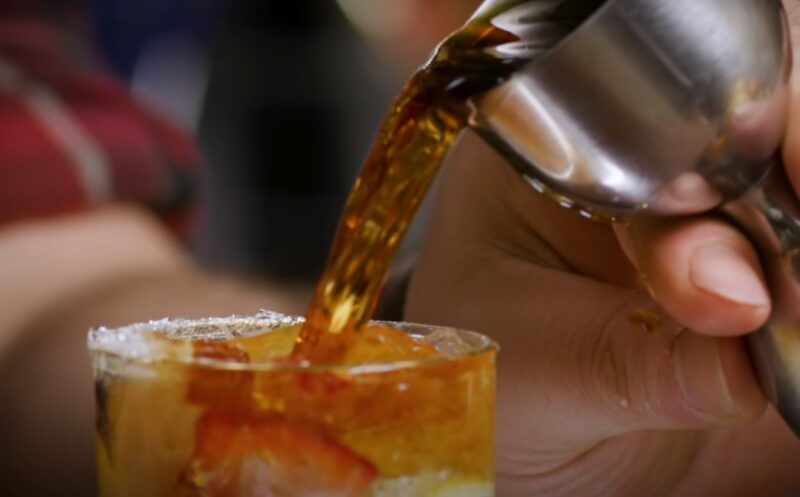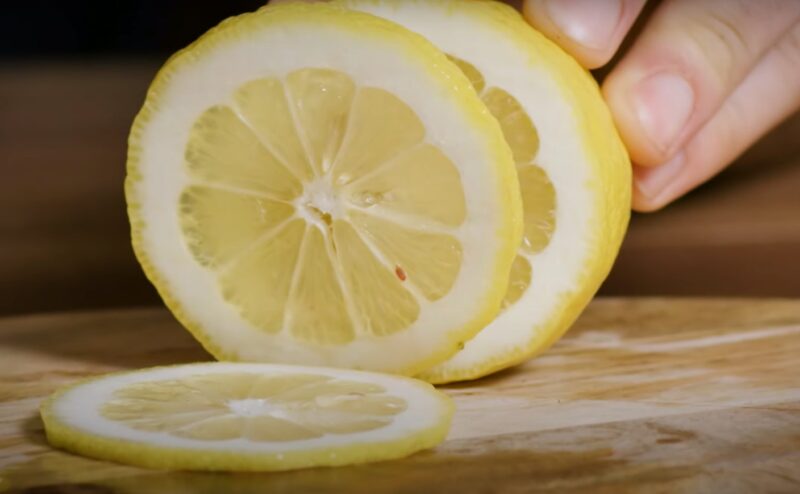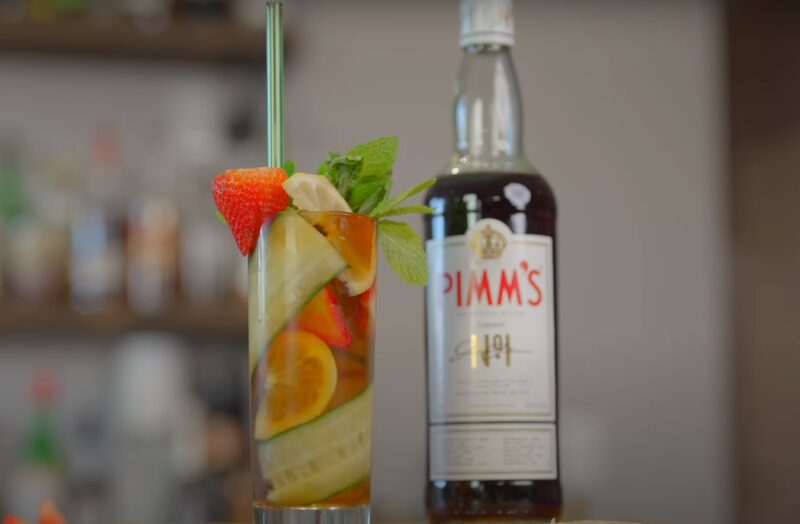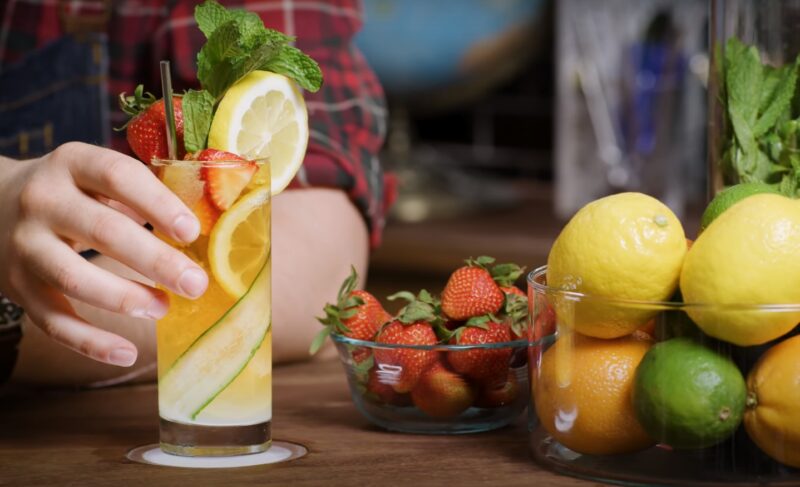Hey there cocktail enthusiasts and history buffs! Buckle up, because we’re about to embark on a delightful journey through the world of Pimm’s Cup – a drink that’s as mysterious as it is refreshing.
Picture this: a sunny afternoon, a glass filled with a tantalizing concoction of gin-based liqueur, fruits, and mint, with a backstory that’s as rich as its taste. From the bustling streets of London to the vibrant corners of New Orleans, Pimm’s Cup isn’t just a cocktail; it’s a globetrotting adventure in a glass. So, grab your favorite drinkware and let’s dive into the fascinating tale of this beloved beverage!
What’s in a Pimm’s Cup?

At its heart, Pimm’s Cup is a delightful mix of freshness and zest. It’s a concoction of mint, chopped fruits, lemonade, and the star ingredient – Pimm’s. This British gin-based liqueur is what gives the cocktail its soul. The deep red hue and the flavor bursting with herbal botanicals, spices, and a hint of caramelized orange are its signatures. The best part? Its recipe is a well-guarded secret, adding to its allure.
Ingredients:
- 50 ml Pimm’s No. 1 liqueur
- 150 ml lemonade (or ginger ale as an alternative)
- Fresh mint leaves
- Assorted fresh fruit (such as cucumber slices, orange slices, strawberries, and apple slices)
- Ice cubes
- Optional: a splash of gin for extra kick
Instructions:

- Prepare Your Ingredients:
- Wash and slice your chosen fruits into bite-sized pieces.
- Pluck some fresh mint leaves.
- Fill the Glass:
- Fill a tall glass or a Pimm’s cup with ice cubes to keep your drink chilled.
- Add Pimm’s:
- Pour 50 ml of Pimm’s No. 1 over the ice. If you like your drink with a bit more strength, you can add a splash of gin here.
- Top with Lemonade:
- Gently pour 150 ml of lemonade over the Pimm’s. You can use ginger ale for a slightly different flavor profile.
- Add the Fruits and Mint:
- Add your prepared slices of cucumber, orange, strawberries, and apples into the glass.
- Slap the mint leaves between your hands (this helps to release the oils and aroma) and then gently place them on top.
- Give It a Gentle Stir:
- Use a cocktail stirrer or a long spoon to gently mix the drink. Be careful not to crush the fruits or mint leaves, as you want them to infuse their flavors slowly.
- Garnish and Serve:
- Add an extra sprig of mint or a fruit slice on the rim of the glass for garnish.
- Serve immediately and enjoy the refreshing taste of your homemade Pimm’s Cup!
Tips:
- Adjust the ratio of Pimm’s to lemonade according to your taste preference.
- For a party twist, make a pitcher using the same ratios and let your guests help themselves.
- Always use fresh fruits and mint for the best flavor experience.
A New Orleans Legend with a British Heart

You might have heard that Pimm’s Cup was born in the 1940s at Napoleon House in New Orleans. The idea was to create a lower-alcohol cocktail so patrons could enjoy longer evenings without going overboard too early. It was perfect for the bar scene, with just enough kick at 25% alcohol.
The True Origins
But here’s a twist – Pimm’s Cup didn’t originate in New Orleans. Its roots trace back to London in the 1840s, thanks to James Pimm. This London oyster bar owner concocted Pimm’s as a health tonic (yes, alcohol was medicinal back then). It became a massive hit and soon spread across the British Empire. How it landed in New Orleans remains a delightful mystery.
More Than Just Mardi Gras
New Orleans, famous for jazz and Mardi Gras (though, fun fact, Mardi Gras originally started in Mobile, Alabama), embraced Pimm’s Cup and made it its own. Despite not being its birthplace, the city has a knack for adopting and celebrating cultural gems.
Pimm’s Cup Variations: Like Gumbo, But Boozy

Just like gumbo, everyone has their own version of Pimm’s Cup. There’s the British way with lemonade and the New Orleans style with Sprite. In the U.S., some even dare to float fruit chunks in it, much to the chagrin of purists. While mixologists love adding their twists, the essence of Pimm’s remains central to this delightful drink.
FAQs
Can I make a non-alcoholic version of Pimm’s Cup?
Absolutely! You can substitute the Pimm’s liqueur with a non-alcoholic gin or a herbal infusion to mimic the botanical flavors. Mix this with lemonade, mint, and fruit to maintain the essence of the original cocktail.
Is there a specific type of fruit that works best in a Pimm’s Cup?
Traditionally, cucumber, strawberries, oranges, and lemons are popular choices. However, feel free to experiment with other fruits like apples or berries for a personal touch. The key is to use fresh, seasonal fruits for the best flavor.
What’s the ideal serving temperature for a Pimm’s Cup?
Pimm’s Cup is best served chilled. You can either mix the ingredients with ice or refrigerate the concoction before serving. It’s refreshing and perfect for warm weather.
Are there different versions of Pimm’s liqueur available?
Yes, Pimm’s has several variations, including Pimm’s No. 1 (the most common, made with gin), Pimm’s No. 3 (brandy-based), and others featuring different base spirits and flavor profiles. Each offers a unique twist to the classic cocktail.
How long can I store a pre-mixed Pimm’s Cup?
If refrigerated, a pre-mixed Pimm’s Cup can last for about 24 hours. However, it’s best consumed fresh to enjoy the vibrant flavors of the fruit and mint.
Can Pimm’s Cup be considered a healthy drink?
While Pimm’s was originally marketed as a health tonic, modern Pimm’s Cup, like most alcoholic beverages, should be enjoyed in moderation. The addition of fresh fruits does contribute some nutritional value, but it’s more a treat than a health drink.
Final Words
And there you have it, folks – the colorful story of Pimm’s Cup, a cocktail that has danced its way through history and across oceans to land in our glasses.
Whether you’re sipping it on a lazy Sunday afternoon or toasting with friends on a warm summer evening, this drink is more than just a mix of ingredients. It’s a sip of history, a dash of mystery, and a whole lot of fun. So next time you mix up a Pimm’s Cup, remember you’re not just preparing a drink, you’re stirring up a story. Cheers to that! 🍹🎉
